He Paki Taonga i a Māui and its English companion, Māui’s Taonga Tales, are the first children’s books of their kind. With children aged 7-12 in mind, they bring to life taonga from Te Papa museum using kōrero o nehera or legends and the historical events surrounding them. Briar Cornwall had the pleasure of speaking to the creators and co-producers of the book and its accompanying TV series, te reo Māori expert and award-winning singer-songwriter Ranea Aperahama and award-winning screenwriter David Brechin-Smith. (You can read this interview in te reo Māori, too.)
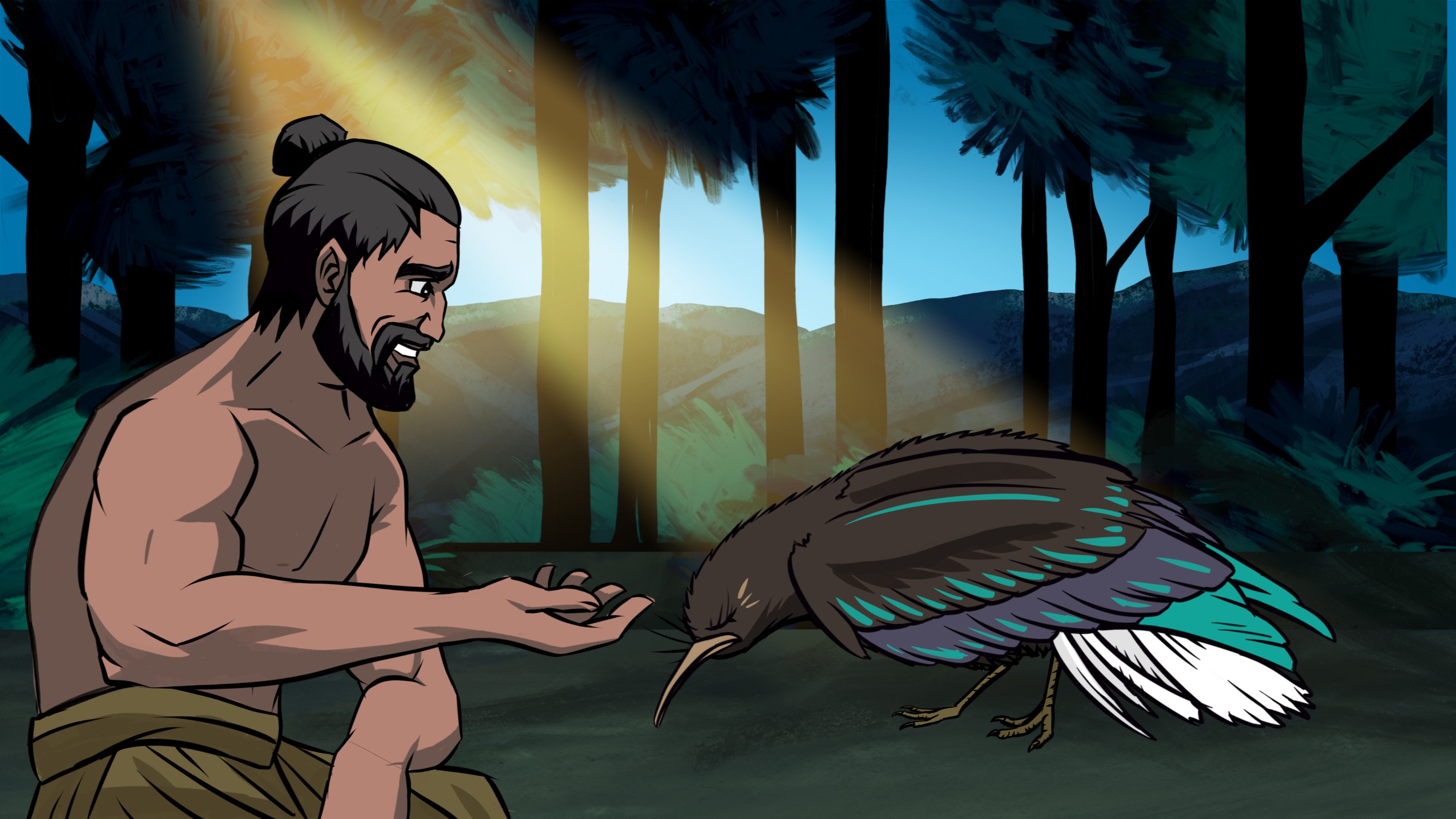
Briar: Kia ora Ranea and David, thank you very much for joining me for this interview. It’s an honour for me to meet you both face to face via this video call. Firstly, tell us about your background and where you come from.
Ranea: Hi Briar, this would be my answer. On my father’s side I am from Muriwhenua or the North Cape area of the North Island and a descendant of the tribes of Te Aupouri and Ngāti Kurī. On the side of my mother I am a descendant of the chiefly lineage of the tribes Tūwharetoa and Tūrangitukua of Te Māpuna. But I was raised on Rātana Pā, a village on the west coast of the North Island, twenty miles away from Whanganui. Therefore there is a relationship to that area, to the tribes of Ngāti Apa and Te Ati Haunui-a-Pāpārangi. I grew up immersed in the customs and traditions of Rātana, that is why I can say that I’m a faithful member.
David:
Tēnā koe,
Nō te Waipounamu au
Nō Ingarangi me Kotimana ōku tīpuna
Ko Takitimu te maunga o tōku rohe
Ko Waihopai tōna awa
Ko Invercargill tōku kāinga.
My father is English and my mother’s father was from Scotland. Brechin is from that side of the family. It’s a name that has been passed down through generations and I have it now.
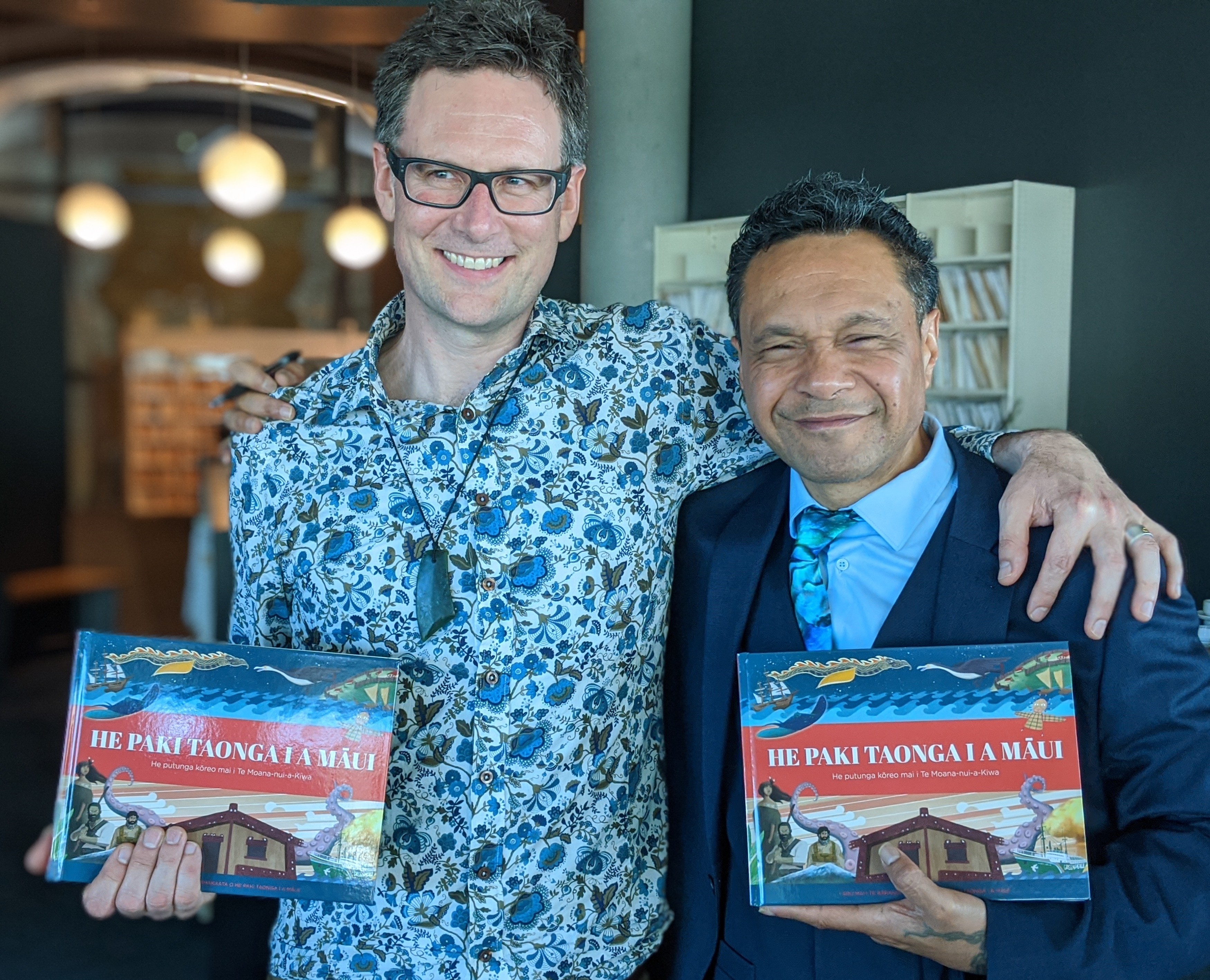
Ranea, can you explain more about your journey with te reo Māori?
My father was raised in te reo Māori, he had a very small knowledge of English. My mother was bilingual. Therefore that was my world. Māori and English were the languages used at home. Apart from te reo Māori being at home, we listened, observed and learnt it in all aspects of our lives including on the marae and in the office of the church because my father used to be the secretary of the church. I learnt a lot from helping our elders with the publication of the newspaper Te Whetū Mārama o Te Kotahitanga. That’s how I first learnt to read and write in Māori. After a while I became the editor of Te Pou Taki Kōrero Whāiti which created Māori resources. After that I became an official translator of te reo Māori.
Can you both explain what you’re doing at the moment?
R: At the moment I’m working as the Māori writer at Te Papa museum, and I’m really enjoying writing and giving words to the precious taonga of this museum. I’ve been writing and researching the stories for nearly four years now. In my spare time when I return home I continue to carve away at these stories.
D: For many years I wrote and filmed in television mainly as a script writer, I’ve written drama series, documentaries, comedy shows, game shows, which is actually where I started, some live entertainment shows and a couple of films. A film I wrote will be released next year – it’s called Lowdown Dirty Criminals. After almost 20 years of doing that, I got a job at Te Papa. I led the Te Papa Writing Team, which is part of the Exhibition Content Team. I did that for almost three years, and now I’m the head tutor at the New Zealand Film and Television School.
Let’s turn our attention to the book now. Where did the inspiration come from to bring to life taonga through their own story and history through a television series and then ultimately this beautiful book.
R: I think the best way that I can explain my answer is with the shape of a meeting house. The tūāpapa or foundation is Papatūānuku; all the foundational work was possible because of the quality of the exhibitions of Te Papa museum. Its posts, the pou tāhū or ridge pole is the mana taonga which is the recognition of the power of taonga to communicate deep truths about our people. The pou tokomanawa or centre ridge pole of a meeting house is the environment and the pou tuarongo or back wall post of the meeting house are the people of the Pacific. The reason why Māui-tikitiki-a-Taranga was chosen to be the tekoteko or figurehead of the meeting house is because Māui is the famous ancestor who belongs to all of the Pacific. He is an ancestor to all of us.
D: Before coming to Te Papa I knew very little about te ao Māori. One of the first major exhibitions that I worked on was ‘Ko Rongowhakaata: A story of light and shadow’ and this was probably my first direct contact with te ao Māori. The whare whakairo Te Hau-ki-Tūranga belongs to Rongowhakaata so they have a longstanding connection with Te Papa. I worked closely with the iwi and with Ranea Aperahama, the Kaituhi Māori at Te Papa. I’ve learned so much from him and he’s helped me to understand the importance of sharing this knowledge, sharing kōrero and the power that is contained within taonga. It was through that exhibition that I came to have a greater understanding of why these things are important to Aotearoa.
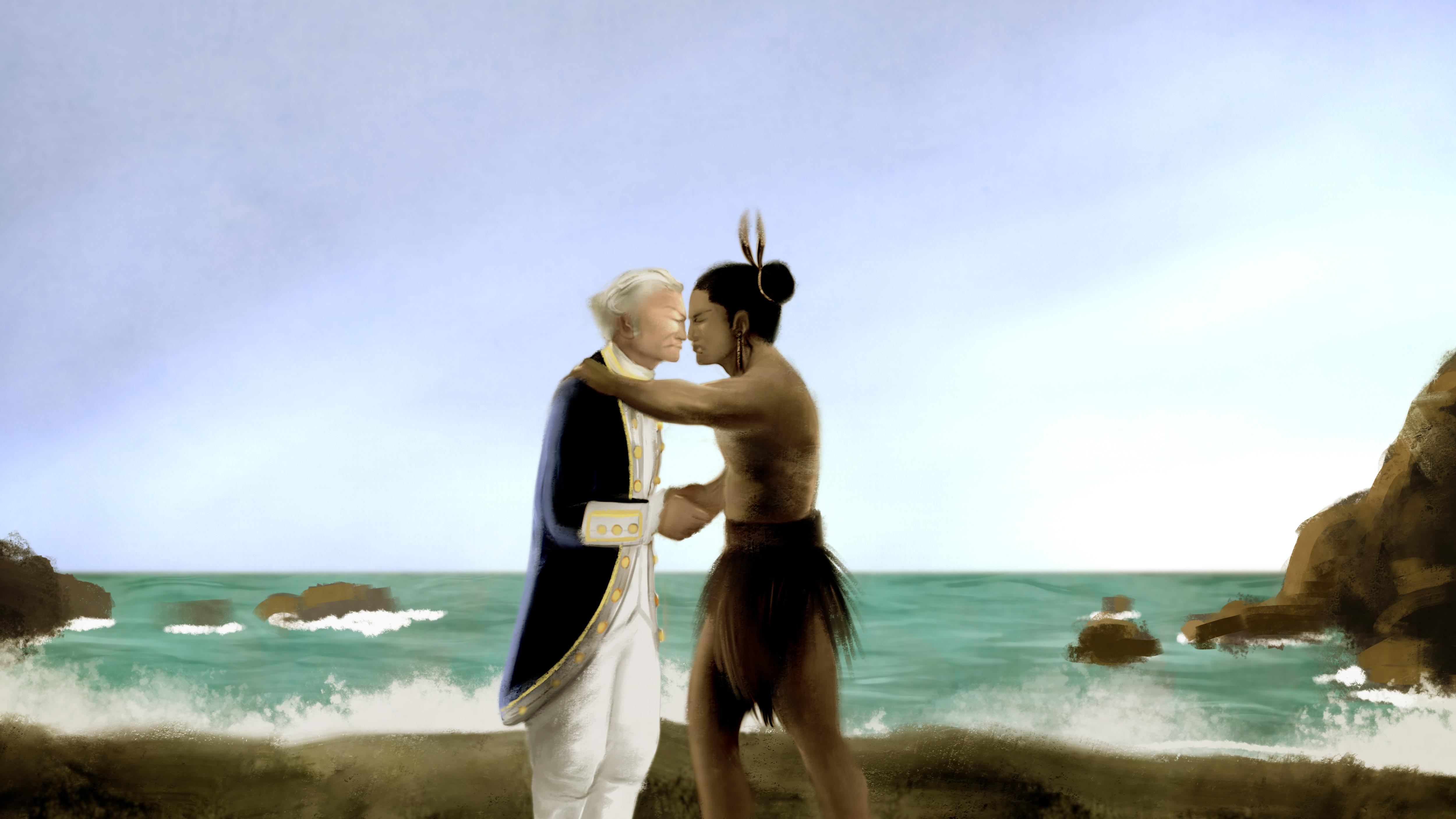
In this exhibition there’s a short animation by Zak Waipara that is about the Cook encounter of 1769, which is a story in He Paki Taonga i a Māui. All the stories and taonga in the book are unique and special but if I was to choose one taonga and its story, it would be the hoe that is the taonga that we used for the story of the Cook encounter. This hoe was traded by the iwi in Tūranganui with Cook’s crew. We had it on display in the Rongowhakaata exhibition and it stood alongside the animation that Zak had created about the encounter. The Cook encounter story was something I’d never come across before and it absolutely captivated me. It was a story of murder and violence and when I grew up, in the history that I learnt, we didn’t think about that side of the story, it really opened my eyes to the fact that there is another story to be told here from another perspective, the Māori side of the story.
That animation and that taonga stands out for me because that’s where I think He Paki Taonga i a Māui started; the idea of using a taonga as a way into the story. I started thinking about what other taonga has a story, or can be used as a way into a story. I told Ranea about this idea I had for a kids’ show and we started to develop it from there.
How did you decide which taonga from Te Papa would feature in your series and then in the book?
D: Ranea and I worked together developing He Paki Taonga i a Māui. We worked with the mātauranga team at Te Papa; Matiu Baker, Puawai Cairns to select taonga.
I also wanted a couple of contemporary stories. I thought it was really important to tell the story of the Rainbow Warrior bombing and we used the Herbs song ‘French Letter’, the 45 record single, as the taonga, the way into that story.
For me it was important to tell that story because it’s a New Zealand story but it’s also a Pacific story. The story is about protecting Te Moana-Nui-a-Kiwa on our back door step and to have kids know that this nuclear testing went on. Sometimes I feel that this knowledge and history fades and we forget about it, and somebody might make the same mistake again. Getting back to the lesser known stories, I also wanted to make sure that I had stories in there about the New Zealand Wars. So we told a couple of stories about the New Zealand Wars but I didn’t want stories where the Māori-Pākeha relationship was explored in a wholly negative way. So these two stories explore this relationship in a positive way because compassion underscores both of them. That was really important to us as well: to have stories with a positive theme. The Rainbow Warrior bombing is a terrible event but the story we tell has also got a positive theme: it’s about protecting the environment. The nature of the story can have negative aspects but what underpins it can be positive. So we tried as much as possible to have positive themes like compassion, kaitiakitanga and courage.
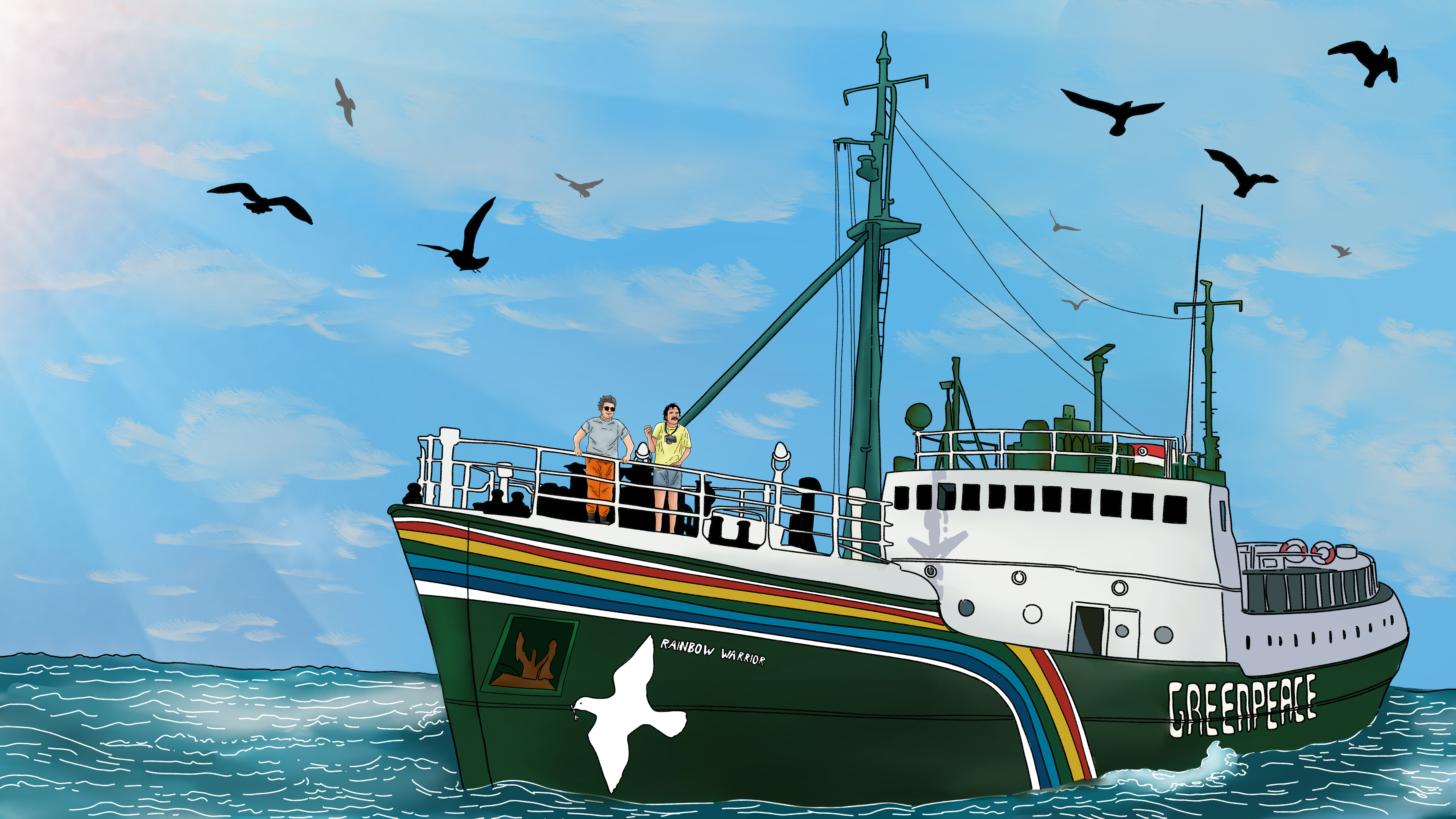
Were there taonga and stories that you wanted to include in the book but weren’t able to include?
D: I really wanted Te Kooti to be in there. Te Kooti is Rongowhakaata. I’d heard of him before but Te Kooti became a fascinating character for me. I wanted to tell the story of his escape from Wharekauri and so we did, we told that story, we got it animated, but at the last minute, we discovered that the taonga that we had associated with the story wasn’t in fact connected to him! So we had to pull the story, but season two will definitely feature Te Kooti now that we’ve got the taonga sorted.
The reason why I bring up Te Kooti is that I wanted to include it for the same reason I wanted the Cook Encounter story. It’s untold history and I wanted to look at stories that were not that well known, if not hidden, not all of them but some of them because I was conscious of the audience of 7-11-year-old kids. You have to strike a balance, if I could get a few provocative stories in there I was happy and Te Kooti was one of those because he’s been misrepresented by some people for over 150 years.
Talk to us about Māui and your choice for him as the storyteller?
D: It was Ranea’s idea to use Māui as the storyteller which was a brilliant idea because Māui reaches through the Pacific. For season two I want to tell stories based around the Pacific, because Te Papa has heaps of taonga from all around the Pacific.
Ranea, tell me about your favourite story or taonga in the book.
My favourite story in this book is the story called Te Ngarohanga o ngā Parirau o te Kiwi. Why? Because it is a story about a Kiwi who has a great love for Tānemahuta, Tāne te-hokahoka. He also has a great love for the environment and a love for his brothers and sisters. He responds to the request of Tāne to find someone who will help him to care for the forest by eating the insects who are damaging it. In his time the Kiwi was a flying bird. But he made the decision, and sacrificed himself and said yes I will. Therefore he lost his wings, and his beak became longer. He would now roam about land, staying close the the ground. That’s an important story for me. For this bird to sacrifice himself in order to save the environment.
The book He Paki Taonga i a Māui is an amazing taonga in itself. It’s clear that a lot of work has gone into to presenting these taonga with stunning artwork and relevant and meaningful contexts. Tell us about the pre-production period and the creative process that went into creating this book.
D: The pre-production period was long, from September 2018 to April 2019. I pulled together the writers and artists. Mathew Grainger, wrote most of the stories and three people from the Te Papa writing team- Victoria Cleal, Frances Samuel, and Jen Craddock- also wrote stories. The stories were all translated and in some cases interpreted by Stephanie Tibble. I was really pleased that she said yes to translating the stories. So the pre-production period was quite long because we undertook to seek support and permission where necessary from iwi, hapū and whānau to use taonga and kōrero connected to these groups. It was a really rewarding process to have the support of the people who the taonga belonged to.
We ended up working with eight Māori artists: Munro Te Whata, Te Hana Goodyer, Ariki Brightwell, Izzy Joy Te Aho-White, Huriana Kopeke-Te Aho, Josh Morgan, Reweti Arapere, and Mirama Grace-Smith. As much as possible we wanted the artists to be illustrating a story that they had a connection to through whakapapa. That didn’t always happen but it did happen with Josh Morgan of Rongowhakaata who illustrated the story ‘Ko Tarakiuta rāua ko Tarakitai’, and Miriama Grace-Smith who illustrated the story of ‘Te Kauranga nui a Kahe’ from Ngāti Toa, and a few others like Munro Te Whata who illustrated the story of Willy Apiata as they’re both from Ngāpuhi.
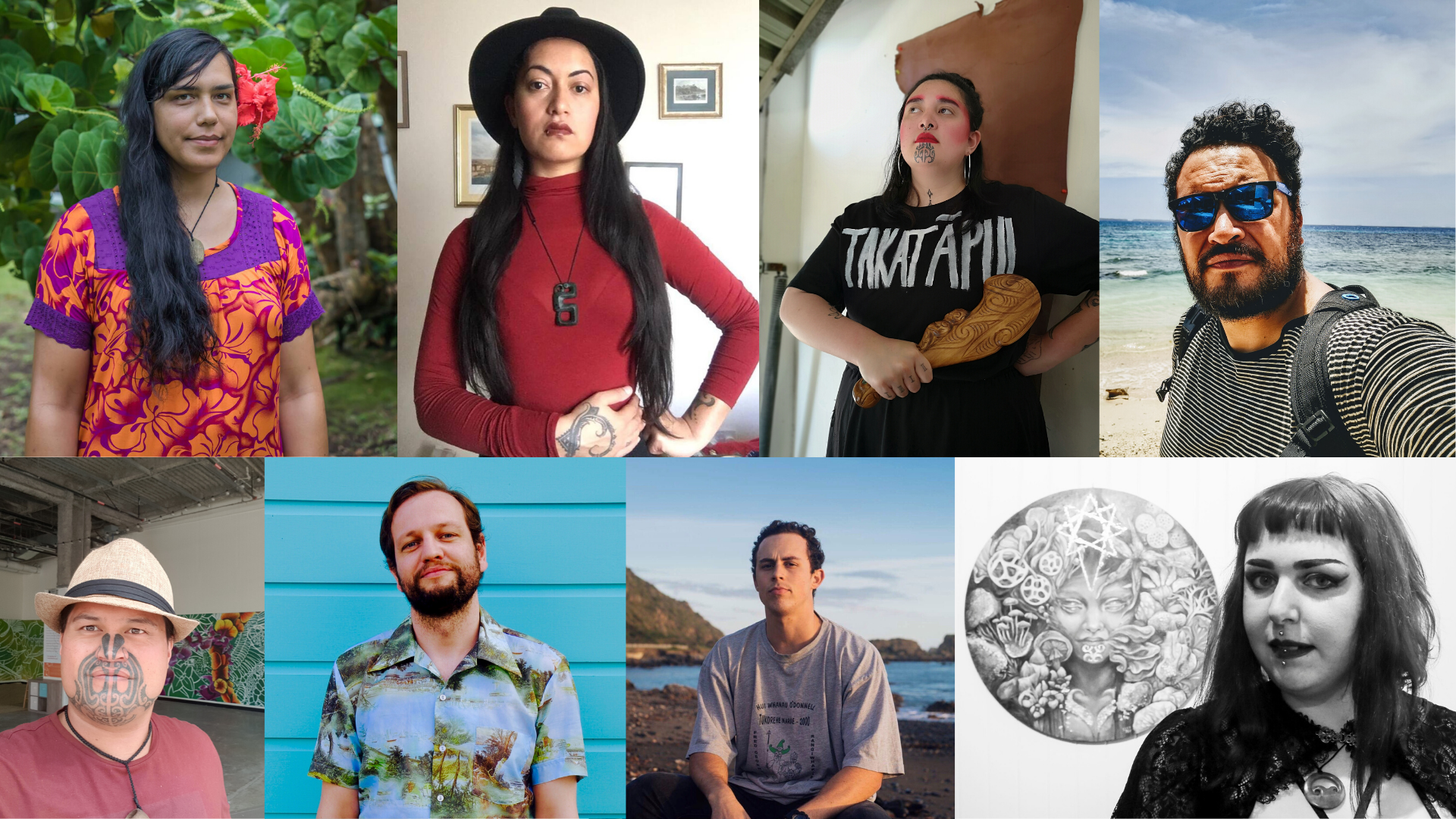
It was really important to me that the stories had different styles visually even if one artist had illustrated multiple stories they all had their own unique style and I think this visual approach helps to further interpret the story. The quality of the artists that we got working on this project was incredible. I remember saying to Ranea one day, ’I’m amazed that we were able to attract such good artist to this project’ and he said that it’s the idea that attracts them. They want to do this because they see the importance in it. Going into this project I didn’t understand to what extent people would connect with the idea and it became quite humbling to me when people starting talking about the idea using words like ‘powerful’ and ‘beautiful’. It was only when other people started to get involved that I began to fully appreciate and understand what we were doing.
Transitioning from the series to the book was a straightforward process thanks to the support of Te Papa. Nicola Legat from Te Papa Press knew that we were doing the web series and asked if we’d be interested in making it into a book. Nicola and Claire Gibb worked really hard to make it happen. It’s quite amazing seeing it in physical form because for so long it was kind of abstract. It’s a strange feeling, I can’t quite put it into words.
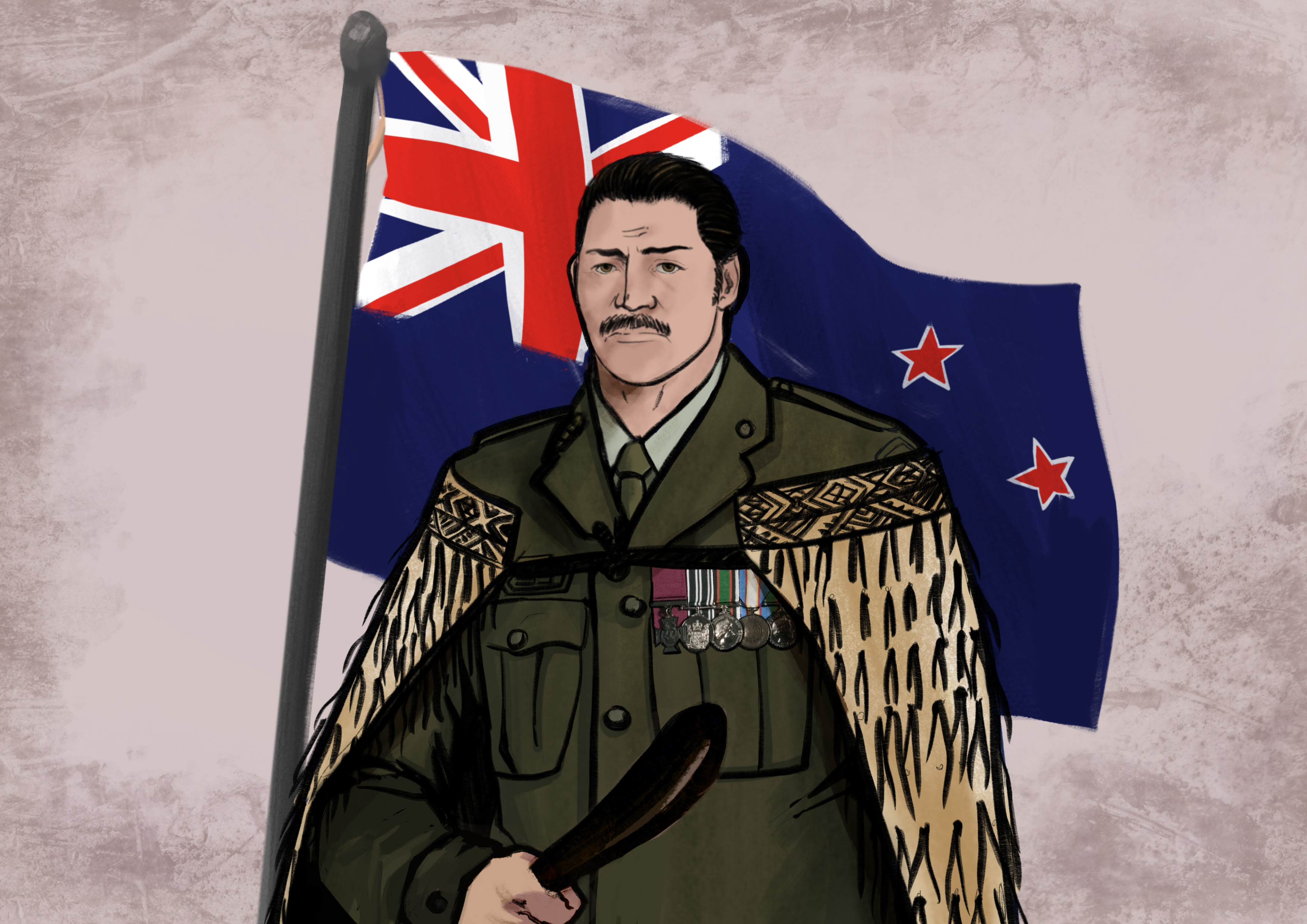
What do you hope will come out of this project?
R: To answer your question. In order to explain myself, I would like to recite a karakia or prayer. The prayer holds within it the very essence of our great aspirations for this project. Let me begin to recite this karakia now;
Oh hidden and sacred treasures
Arise and awaken from your sleep
Let your voice be expressed, to convey understanding
Let your appearance be articulated, to bear healing to your descendants
Let your purpose be communicated, anchoring the language in your descendants
Through your footsteps a way forward is now possible
For your words are a lantern unto my feet, a light unto my pathway
Guide me on the path of responsibility
Guide the repository on its journey
Guide and allow me to speak of you
The sun shines, your essence, your delight and passion shall radiate
An honourable calling – as a great gift bestowed to the world.
Let’s have applause for He Paki Taonga i a Māui!
As a teacher of te reo and a mother of four children I’m so grateful for this resource and am appreciative of the hard work that has gone into it. This book fills a gap in current te reo Māori books for children from Year 5 to Year 8. Did you know that there was a great demand for books like this in te reo which cater for children who are fluent and needing more advanced language and themes?
R: Yes, I’ve read a lot of books. As I said I used to work for a publishing company called Te Pou Taki Kōrero. The company is no longer running but they produced Māori language resources for school throughout the country. The translation was done by Stephanie Tibble. She is a real expert and in the past she was a te reo Māori Teacher. So she completely understands the world of the teacher. If it wasn’t for Stephanie the project would not have been a success. She was also given the liberty interpret the story. I said to her that it didn’t have to all be translated word for word. In the English version you’re not able to see the nuances used in the interpreted version which can eloquently express the histories and legends of our forefathers. Therefore you have an English version which is another view point, another path for them, but when you turn to our Māori world view, therein lies the depth and breadth that you can’t see in the English translation.
D: I had no idea that there was that gap in the market. Ranea had mentioned it to me along the way. The reason that I chose the age range 7-12 was more because of the types of stories that we wanted to tell. That age range allowed us to tell a really interesting range of stories and the language approach itself is really accessible in both English and in Māori. This is where I was really careful about who wrote the English and then who translated and interpreted into Māori because I knew that those people were able to bring that tone to the stories. Some of the stories that I’ve read in the other books are quite dry and they didn’t feel very contemporary.
Victoria Cleal wrote the story called The Battle of the Birds. She wrote this line about this character who was jealous in the way that you get jealous of your cousin’s new sneakers, it was a story about this old myth and I thought that’s it, that’s the tone of He Paki Taonga. All the writers were great in bringing that more contemporary, accessible, friendly, warm tone to the stories. Funny where you needed to be funny and serious where you needed to be serious. I’m really pleased to hear that this is filling a gap between the more academic style of language and the younger language books. This is where Stephanie was so valuable too-she understands it, she gets it.
Thank you so much matua Ranea, it’s been such an honour to meet you and to listen to your dialect from the north, it’s very beautiful. I am from the Takuira family of Panguru.
That’s great, I greet us and our whānau ties.
There is a connection there and also Matangirau is where my grandmother is from. It was wonderful to listen to you speak Māori, It reminds me of her language which was very entertaining. Thank you for making yourself available for the interview.
Be well and have a good time in France.
Thanks again for your time David, you and your team have done an amazing job. I’m looking forward to giving this book to my 10 year old to read and for all of the whānau to enjoy. Ka kite anō.
That would be great to know what she thinks, they’re the true critics! Nice to meet you. Be well.
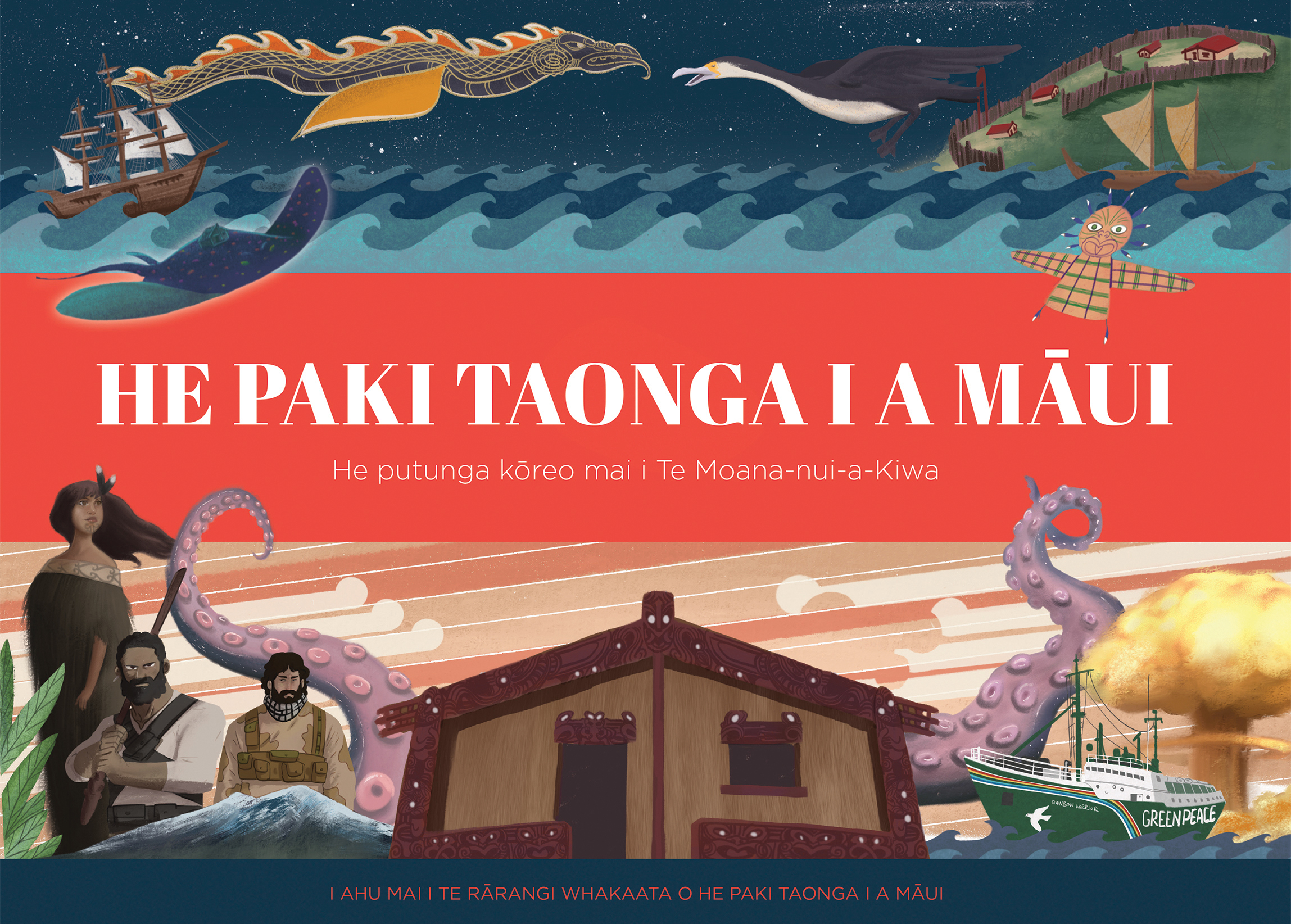
He Paki Taonga i a Māui
Nā Stephanie Tibble i whakamāori
Te Papa Press
RRP: $29.99 (hardback)
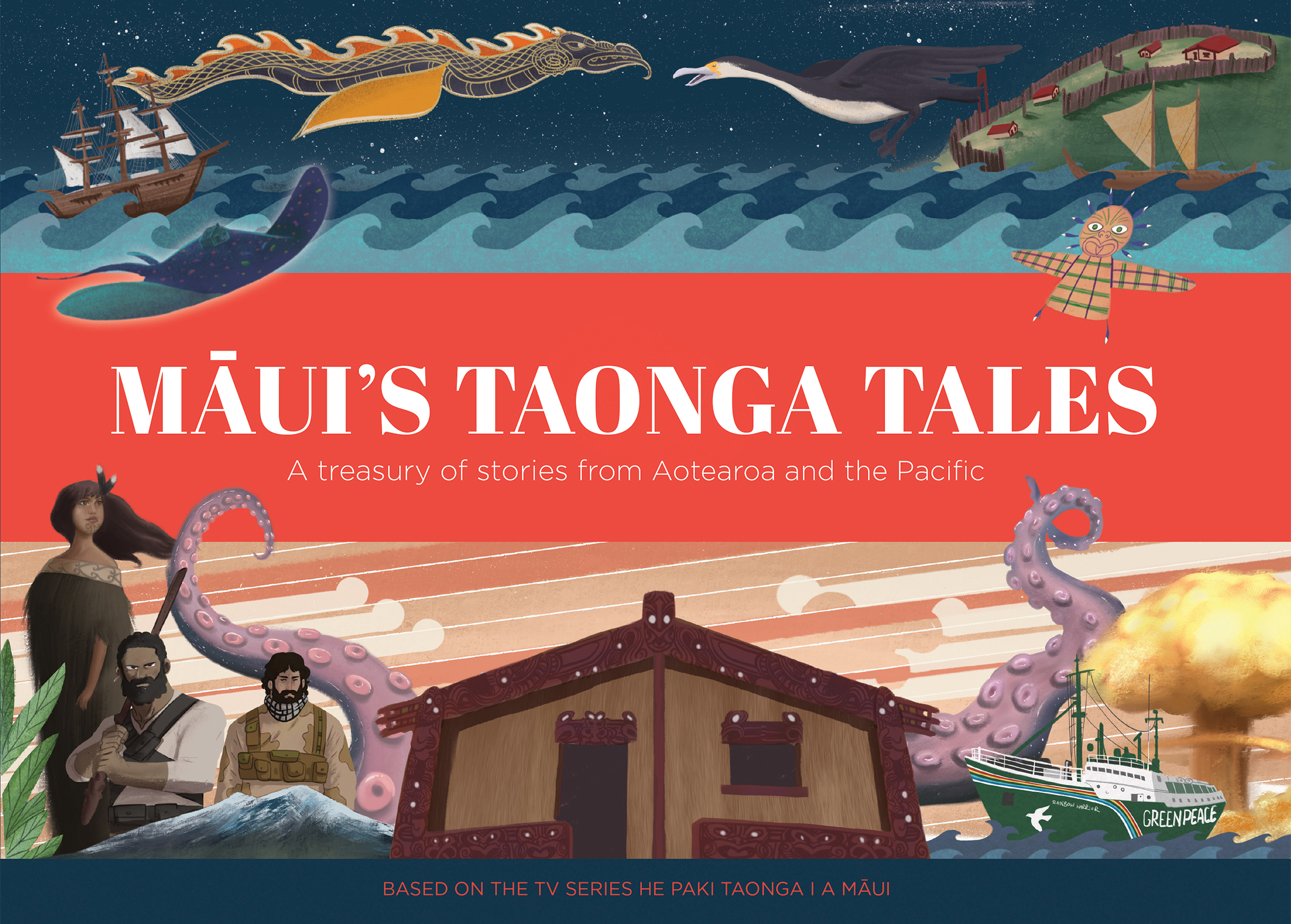

Briar Cornwall
Ko Panguru te maunga
Ko Whakarapa te awa
Ko Ngātokimatawhaorua te waka
Ko Te Rarawa, Ko Ngāpuhi ngā iwi
Ko Ngāti Manawa, Ko Te Kaitutae ngā hapū
Ko Ngāti Manawa te marae
Ko Tiapakeke Teihi te tūpuna
E noho ana a Briar ki Wīwī me tana tane me ā rāua tamariki tokowhā. He māhita kura ia o Te Reo Māori me te Kapa Haka i ngā tau 15 kua pāhure. Ko te aka matua e ū nei a ia ko te whakapono me te whānau.
Briar lives with her husband and four children in France. She has taught Te Reo Māori and Kapa haka for over 15 years. What grounds her in life are her faith and her whānau.



